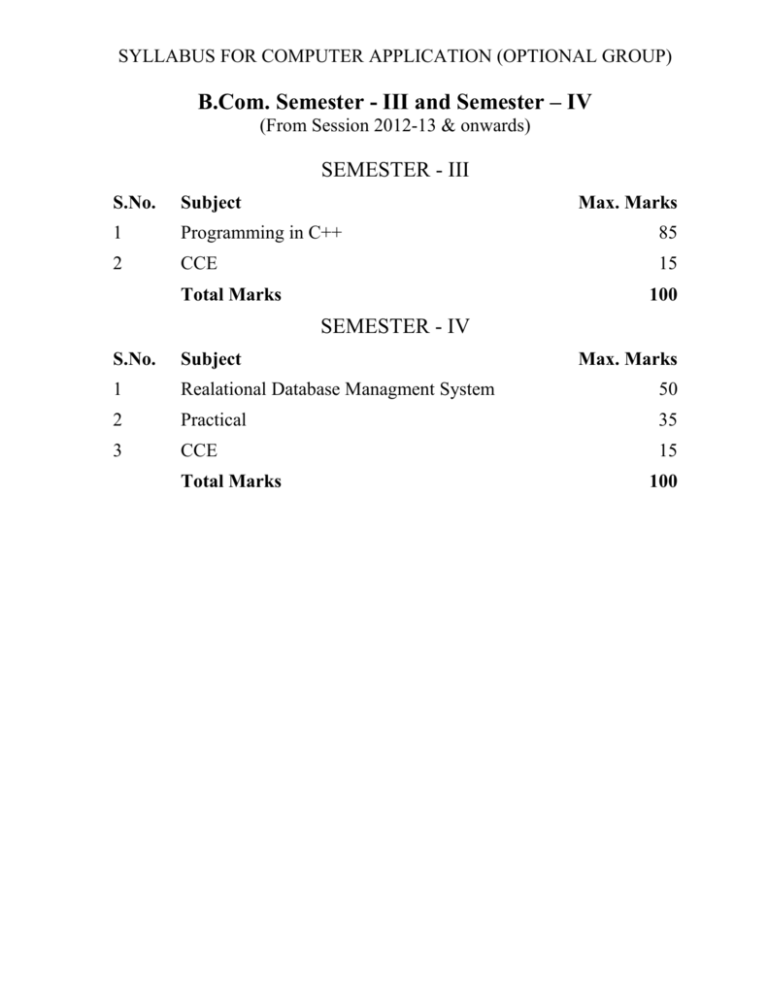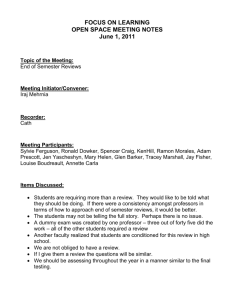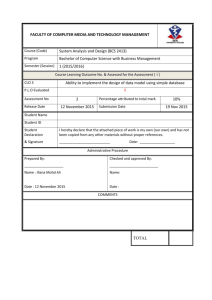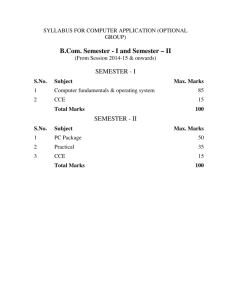B.Com. Semester - III and Semester – IV
advertisement

SYLLABUS FOR COMPUTER APPLICATION (OPTIONAL GROUP) B.Com. Semester - III and Semester – IV (From Session 2012-13 & onwards) SEMESTER - III S.No. Subject Max. Marks 1 Programming in C++ 85 2 CCE 15 Total Marks 100 SEMESTER - IV S.No. Subject 1 Realational Database Managment System 50 2 Practical 35 3 CCE 15 Total Marks Max. Marks 100 COMPUTER APPLICATION (OPTIONAL GROUP) SEMESTER - III PAPER - I PROGRAMMING IN C++ Max Marks : 85 UNIT - I Algothrithms for Problem Solving Flowchart, Flowchart Symbols, Rules of Flowcharting,example of flowchart, what is programming, modular programming,procedure oriented programming, Object oriented programming concept : Class, Object, Data abstraction & Encapsulation, Inheritance, Polymorphism & Message Passing, Benefits of OOPS. UNIT - II Programming in C++ - Structure of C++ Programme, Elements of C++ Tokens, identifiers, data types in C++, Constants and its types Standard input and standard output Statements output – cout , Use of << and >> operators Control Structure in C++ (Sequence Selection and Iteration) , Structured datatypes in C++ arrays, What is Function , recursive function , Inline Function. UNIT – III Structure of class , declaration of class , member function, declering function outside of class , Constructors , default constructor , constructor overloading, Destructors , Friend function , polymorphism - Virtual Function , this pointer.Create programe using class. UNIT – IV What is function Overloading , rules for function overloding , function Operator overloading- Rules for Operator overloading, Overloading Unary Operator, Overloading Binary Operator, overloading assignment operator Pointers : Declaration and Initialization of Pointers UNIT – V Inheritance : Introduction , types of derivation – public , private , protected inheritance. Types of Inheritance (Simple, Multilevel, Multiple, Heirarchical and Hybrid). Create program using inheritance. Reference Books 1. Programing in C++ - Balaguruswami, English 2. Programming with C++ (2nd) – D. Ravi Chandran 3. C++ Programming - Hemant Kumar Goyal, Hindi COMPUTER APPLICATION (OPTIONAL GROUP) SEMESTER - IV PAPER - II RELATIONAL DATA BASE MANAGEMENT SYSTEM MAX MARKS – 50 PRACTICAL – 35 UNIT - I Introduction to Data Base, Database files, records & fields, problems with manual database, using computers for database, categorization of DBMS systems (Networks, Hierarchical & Relational databases , what is RDBMS, Application of RDBMS system, Advantages and limitations over DBMS, UNIT - II Definition of CODD's rules, Important components-database manager, DDL, DML, DCL, query processor, data dictionary, concept of entities, attributes & relationships, ER diagrams, basic concept associated with Normal forms. UNIT - III Introduction to ORACLE,oracle architecture and product history,. Introduction to SQL, SQL operators, data types DDL commands(create table, alter table, drop table, create view, rename, create index) DML commands of SQL, (select distinct, select from where, select from where order by, select group by clause, select group by having clause, insert into, update, delete) DCL commands of SQL (Rollback, revoke, grant). UNIT - IV SQL aggregate functions (sum, avg, max, min, count) SQL Character functions (Lower, upper, length, substr, RPAD, LPAD) SQL arithmetic functions (Round, trunc, sqrt, mod, abs, sine) conversion functions and other miscellaneous functions. Joining Multiple Tables (equi joins), Joining a table to itself (self join), subqueries union, intersects and minus clause. UNIT - V Report using SQL plus (specifying column heading, formatting columns char formats, break, inserting spaces after every row, break on multiple column with different spacing, page size, line size, pause). Introduction of PL/SQL, PL/SQL datatypes, Using PL/SQL Blocks in the SQL*plus Enviornment ,control statements(if-the-else,loop,while-loop,for-loop) ,error handling in PL/SQL, introduction to cursor handiling,types of cursor(Explicit Cursor & Implicit Cursor),general cursor attributes. Reference Books 1. Oracle 8i - Freeman & Blomberg, English 2. Siplified approch to Oracle- Prateek Bhatia,Sanjiv Datta,Ranjit Singh 3. Oracle & Developer 2000 - Ivan Bay Rose, English 4. A to Z Oracle - Hemant Kumar Goyal, Hindi SYLLABUS FOR COMPUTER APPLICATION (OPTIONAL GROUP) B.Com. Semester - V and Semester – VI (From Session 2012-13 & onwards) SEMESTER - V S.No. Subject Max. Marks 1 E-Commerce and Accounting Pacakage 85 2 CCE 15 Total Marks 100 SEMESTER - VI S.No. Subject 1 Visual Basic 40 2 Major Computer Project + Practical 50 3 CCE 10 Total Marks Max. Marks 100 COMPUTER APPLICATION (OPTIONAL GROUP) SEMESTER - V PAPER - I E-COMMERCE AND ACCOUNTING PACKAGE Max Marks : 85 UNIT - I Introduction to Internet, Web Browsers, www, types of network – LAN and WAN, Email Basics - Working with E-mail, how to send and receieve e-mails. Search Engine. E-Commerce : Business Operations; E-Commerce Practices vs traditional business practices; Benefits of e-commerce to organization, consumers and society; Limitation of ecommerce; Management issues relating to e-commerce. UNIT - II Operations of E-Commerce, Credit Card transation, Secure Hypertext Transfer Protocol, Electornic Payment Systems, Secure Electronic transaction, Broker based Service, Online travel tourism services, Benefits and impact of e-commerce on travel industry, Real estate market, Online stock trading and its benefites, Online Banking and its benefits, UNIT - III Introduction to E-Governance, EDI in governance, E-Government, E-governanceapplicatin of the internet, concept of government-to-business, business to-government andcitizen-to-government, e-governance models. UNIT - IV Accounting Information System : Basics of Accounting Practices and Preparation of Final Accounts. Introduction to Computerised Accounting Information Systems. Distinction between Manual and Computerised Accounting Information Systems, Accounts Payable Systems, Accounts Receivable System. Introduction to Tally, Creating New Company, Creation of Groups and Accounts, Making vouchers entries, working with dates and all menus of Tally package, Generation of Reports Recording of Inventory UNIT - V Basic concepts of Inventory Tally Configuration, Single & Multiple User, Tally Screen Components, Mouse / Keyboard Conventions & Key, Combinations, Switching between screen areas, Quitting Tally. Maintaining Company Data, Basic Company Details, Create/Alter/Select/Load/Close a Company, Chart of Accounts, Company Features, Configuration. Creating Group company, Use of Tally vault, Using Security control & defining different security levels, Use of Tally Audit. Back-up & Restore, Splitting company data, Export & import of Data. Reference Books 1. Networking & Data Communication - Nitin K. Naik, Both Hindi/English 2. Data Communication & Computer N/W - Sanjay Pahuja, English 3. E- Commerce - M. K. Saxena, English 4. E-governance - Shashi Chawla, Hindi 4. Financial Account with Tally- Mukti Jain COMPUTER APPLICATION (OPTIONAL GROUP) SEMESTER - VI PAPER - II VISUAL BASIC MAX MARKS – 40 MAJOR COMPUTER PROJECT + PRACTICAL – 50 CCE - 10 UNIT - I Introduction to Programming -Modular Programming, Object Oriented Programming, Event Driven Programming: About Visual Basic (Object Based Programming Language), Rapid Application Development using Visual Basic;Getting Familiar with Visual Basic User Interface-Pull-Down menus, Toolbar, Toolbox, Project Explorer, Properties Window, Form Layout Window, Form Immediate window; Opening and Closing window, Resizing and moving windows, Quitting Visual Basic. UNIT - II Visual Basic Tool Box (Standard Window Controls)- Pointer, Picture Box, Label, Text Box, Frame, Command Button, Check Box, Option Button, Combo Box, List Box, Horizontal Scrollbar, Vertical Scrollbar, Timer, Shape, Line, Image Box. msgbox and input box. UNIT - III Data Types: Integer, Long, Single, Double, Currency, String, Byte, Boolean, Date, Object, Variant;Variables: Need to use variable, Declaring Variables, Variable Naming Convention, Assigning value to Variables, Data Types of variable, Scope and lifetime of Variables (Public and Private); Controll Flow statements,(Decision and looping),msgbox and input box. UNIT - IV Menu Editor : Concept of menus, Shortcut menus and Popup menus Designing Menu System, Menu Editor Dialog Box Options ,drop-down menu and popup menu.MUltiple Document Interface, CReating and MDI form, Setting up MDI child Form, Creating Procedures,passing parameteres,other built-in functions. UNIT - V General Controls (Advance):Common Dialog control(color, font,open,save and save as), data base using vb6.0,Data control and data bound control,data bound grid control,using ADO data control,data grid control.error handling. Reference Books 1. simplified approach to Visual Basic – prateek bahatia,ranjit singh etc. 2. Mastering VB








